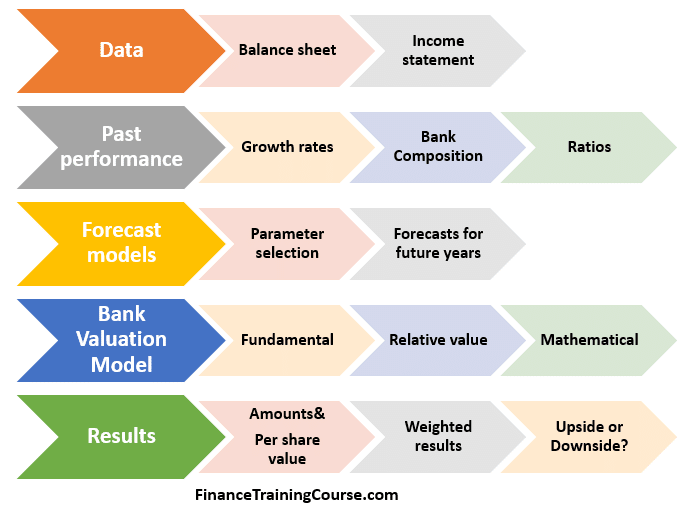The Emirates Bank International and National Bank of Dubai (EBI-NBD) transaction serves as our primary case study for the upcoming Bank valuation course. Two large banks merge to create the 4th largest bank in the region. Looking at them in isolation as well as combination gives us a sense of synergies and cost reductions.
The case study walks through the timeline of the Emirates NBD transaction. Within the course we share two separate set of financials for the two banks in questions using pre and post merger data. Using the context of Mergers and acquisitions (M&A) market in Middle East, the core questions deal with transaction drivers. What really drives bank consolidation transactions in the Middle East? Cost efficiency? Scale? Or access to customer and relationship networks?
While the transaction itself is dated, it still serves as the benchmark for local and regional consolidation moves within the banking industry.
Bank Valuation Model
One of the core objectives of the course is to focus on strategic analysis once the underlying valuation models have been built. We include a simplified bank model for Bank A, Bank B and the merged New Bank.
The Excel model and data sheet included in the course consists of six Data tabs, three each for EBI and NBD respectively covering the balance sheet, income statement and breakup of loans. The tabs are:
- EBI-Data-BS
- EBI-Data-IncSt
- EBI-Data-LoanBreakUp (for the gross loan & provision amounts)
- NBD-Data-BS
- NBD-Data-IncSt
- NBD-Data-LoanBreakUp (for the gross loan & provision amounts)
In the data tab the published data is translated to the input format of the forecast model:

Bank Valuation case study – EBI – NBD Timelines
1999: Initial merger talks between the two banks are way-laid on the death of NBD chairman.
March 2007: Surprise announcement of merger deal between EBI & NBD. Central Bank of UAE and the stock exchange claim that they are not aware of the deal. It is believed that the emirates’ ruler, Sheikh Mohammed bin Rashid al-Maktoum agreed to this merger.
Believed motivations of the merger are:
- To prepare & grow the UAE banking sector for competition with international banks in light of trade deals being negotiated with the US and EU
- To cope with a rapidly growing economy
- To protect market share
- To reduce the fragmentation of UAE banking system and encourage further consolidation in the region
Dubai stock exchange halts trade of the shares of the two entities until further information is received on the merger from the entities involved. S&P raises ratings from positive to stable for both banks.
April 2007: Goldman Sachs wins contract to advise the two banks on the merger.
June 2007 (Q2 2007): Net profits of both entities rise (year on year basis) – EBI by 70% with net income of AED 626 million & NBD by 41.2% with net income of AED 433.90 million.
July 2007: Details of the deal are released. Exchange ratio of 1 ENDB share for every EBI share worth AED 9.30 per share and 0.95 ENBD share for 1 NBD share worth AED 8.84 per share.
EBI shareholders will have a 66.3% stake in the ENDB while, NDB shareholders will have a 33.7% stake. The Dubai government owns 56% of ENDB.
The deal is expected to create AED 151 million of cost synergies (from retail branch and ATM consolidation, card acquisition and price advantages, IT operations consolidation) and AED 195 million of revenue synergies (from cross selling opportunities and increased risk tolerance).
September 2007: EBI & NBD shareholders approve the merger deal.
7 October 2007: Shares of EBI & NBD stop trading on the Dubai bourse.
14 October 2007: EBI & NBD merge into a new entity Emirate NBD (ENDB) in a $11.3 billion (by market cap) deal planned by the government of Dubai, the largest in UAE history.
15 October 2007: Shares of EBI & NBD are delisted from the Dubai Financial Market.
16 October 2007: Shares of ENBD are listed on the Dubai Financial Market. The bank provides corporate, retail, private, Islamic and investment banking throughout the region.
Reference
- http://www.arabianbusiness.com/m-a-activity-could-spiral-in-dubai-banking-sector-148230.html#.V0g46Pl96M8
- http://www.arabianbusiness.com/goldman-sachs-advise-on-dubai-banks-merger-146651.html#.V0g49vl96M8
- http://www.arabianbusiness.com/nbd-ebi-in-shock-bank-merger-148254.html#.V0gpUfl96M8
- http://www.arabianbusiness.com/emirates-bank-nbd-profits-surge-58233.html#.V0gpLPl96M8
- http://www.arabianbusiness.com/ebi-nbd-shareholders-decide-on-merger-by-september-199235.html#.V0gpFvl96M8
- http://www.arabianbusiness.com/ebi-nbd-provides-merger-model-for-gulf-banks-199332.html#.V0gpL_l96M8
- http://www.arabianbusiness.com/emirates-bank-nbd-shares-suspended-54190.html#.V0gpO_l96M8
- http://www.arabianbusiness.com/ebi-nbd-provides-merger-model-for-gulf-banks-199332.html#.V0gpL_l96M8
- http://www.arabianbusiness.com/dubai-ruler-demands-nbd-ebi-merger-148257.html#.V0g43Pl96M8
- Bank Valuation Study Guide – Jawwad Farid, May 2016, FinanceTrainingCourse.com
